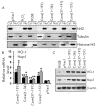Analysis of the Domains of Hepatitis C Virus Core and NS5A Proteins that Activate the Nrf2/ARE Cascade
- PMID: 27795852
- PMCID: PMC5081703
Analysis of the Domains of Hepatitis C Virus Core and NS5A Proteins that Activate the Nrf2/ARE Cascade
Abstract
The hepatitis C virus (HCV) triggers a chronic disease that is often accompanied by a spectrum of liver pathologies and metabolic alterations. The oxidative stress that occurs in the infected cells is considered as one of the mechanisms of HCV pathogenesis. It is induced by the viral core and NS5A proteins. It is already known that both of these proteins activate the antioxidant defense system controlled by the Nrf2 transcription factor. Here, we show that this activation is mediated by domain 1 of the NS5A protein and two fragments of the core protein. In both cases, this activation is achieved through two mechanisms. One of them is mediated by reactive oxygen species (ROS) and protein kinase C, whereas the other is triggered through ROS-independent activation of casein kinase 2 and phosphoinositide 3-kinase. In the case of the HCV core, the ROS-dependent mechanism was assigned to the 37-191 a.a. fragment, while the ROS-independent mechanism was assigned to the 1-36 a.a. fragment. Such assignment of the mechanisms to different domains is the first evidence of their independence. In addition, our data revealed that intracellular localization of HCV proteins has no impact on the regulation of the antioxidant defense system.
Keywords: Hepatitis C virus; Nrf2; oxidative stress; regulation; transcription factor.
Figures



Similar articles
-
Hepatitis C virus proteins activate NRF2/ARE pathway by distinct ROS-dependent and independent mechanisms in HUH7 cells.PLoS One. 2011;6(9):e24957. doi: 10.1371/journal.pone.0024957. Epub 2011 Sep 13. PLoS One. 2011. PMID: 21931870 Free PMC article.
-
Hepatitis C Virus Proteins Core and NS5A Are Highly Sensitive to Oxidative Stress-Induced Degradation after eIF2α/ATF4 Pathway Activation.Viruses. 2020 Apr 9;12(4):425. doi: 10.3390/v12040425. Viruses. 2020. PMID: 32283772 Free PMC article.
-
Hepatitis C Virus NS5A Protein Triggers Oxidative Stress by Inducing NADPH Oxidases 1 and 4 and Cytochrome P450 2E1.Oxid Med Cell Longev. 2016;2016:8341937. doi: 10.1155/2016/8341937. Epub 2016 Apr 20. Oxid Med Cell Longev. 2016. PMID: 27200149 Free PMC article.
-
The nonstructural NS5A protein of hepatitis C virus: an expanding, multifunctional role in enhancing hepatitis C virus pathogenesis.J Biomed Sci. 2002 May-Jun;9(3):187-97. doi: 10.1007/BF02256065. J Biomed Sci. 2002. PMID: 12065893 Review.
-
Effect of Hepatitis Viruses on the Nrf2/Keap1-Signaling Pathway and Its Impact on Viral Replication and Pathogenesis.Int J Mol Sci. 2019 Sep 19;20(18):4659. doi: 10.3390/ijms20184659. Int J Mol Sci. 2019. PMID: 31546975 Free PMC article. Review.
Cited by
-
Progressive Rotavirus Infection Downregulates Redox-Sensitive Transcription Factor Nrf2 and Nrf2-Driven Transcription Units.Oxid Med Cell Longev. 2020 Apr 4;2020:7289120. doi: 10.1155/2020/7289120. eCollection 2020. Oxid Med Cell Longev. 2020. PMID: 32322337 Free PMC article.
-
The Role of the NRF2 Pathway in the Pathogenesis of Viral Respiratory Infections.Pathogens. 2023 Dec 31;13(1):39. doi: 10.3390/pathogens13010039. Pathogens. 2023. PMID: 38251346 Free PMC article. Review.
-
Oxidative stress, a trigger of hepatitis C and B virus-induced liver carcinogenesis.Oncotarget. 2017 Jan 17;8(3):3895-3932. doi: 10.18632/oncotarget.13904. Oncotarget. 2017. PMID: 27965466 Free PMC article. Review.
-
Nrf2 Negatively Regulates Type I Interferon Responses and Increases Susceptibility to Herpes Genital Infection in Mice.Front Immunol. 2019 Sep 6;10:2101. doi: 10.3389/fimmu.2019.02101. eCollection 2019. Front Immunol. 2019. PMID: 31555293 Free PMC article.
-
Hepatitis C Virus Non-Structural Protein 5A (NS5A) Disrupts Mitochondrial Dynamics and Induces Mitophagy.Cells. 2019 Mar 29;8(4):290. doi: 10.3390/cells8040290. Cells. 2019. PMID: 30934919 Free PMC article.
References
-
- Lemon S.M., Walker C.M., Alter M.J., Yi M.K. Fields Virology. Philadelphia: Lippincott, Williams & Wilkins, 2007. 2007. Hepatitis C virus; pp. 1253–1304.
-
- Okuda M., Li K., Beard M.R., Showalter L.A., Scholle F., Lemon S.M., Weinman S.A.. Gastroenterology. 2002;122(2):366–375. - PubMed
LinkOut - more resources
Full Text Sources
